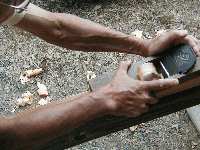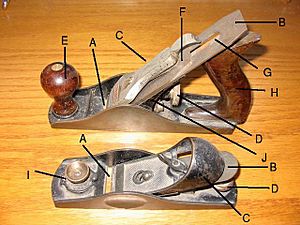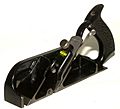Plane (tool) facts for kids
A plane is a tool used for shaping wood. Planes help make wood flat, thinner, and super smooth. They turn a rough piece of lumber into a perfectly level surface.
Hand planes have a sharp metal blade attached to a solid body. When you push a plane over wood, it shaves off thin layers. This makes the wood very smooth because the plane glides over any high spots and keeps the blade at the right angle.
Hand planes are very old tools, first used thousands of years ago. Early planes were made from wood. Their blades were first made from bronze, then iron, and later steel. The cutting blade was often held in place with a wooden wedge.
Parts of a Wood Plane
Here are the main parts of a plane:
- A: The Mouth is an opening in the bottom of the plane. The blade extends through it, and wood shavings pass up through it.
- B: The Iron is the sharp steel blade that cuts the wood.
- C: The Lever cap holds the blade firmly against the plane's body.
- D: The Depth adjustment knob controls how far the blade sticks out through the mouth. This changes how deep the cut is.
- E: The Knob is a handle at the front of the plane, used for gripping.
- F: The Chipbreaker or Cap iron makes the blade stronger. It also curls and breaks the wood shavings as they pass through.
- G: The Lateral adjustment lever helps you adjust the blade. This makes sure the cut is even across the entire width of the mouth.
- H: The Tote is the main handle at the back of the plane.
- I: The Finger rest knob is found on block planes. Users rest their index finger in this spot for better control.
- J: The Frog is a special metal wedge. It holds the plane's iron at the correct angle. It can slide to adjust the gap between the blade and the front of the mouth.
Types of Wood Planes
Different types of planes are designed for specific tasks. They are often used in a certain order:
- A scrub plane quickly removes large amounts of wood. It is usually about 9 inches (230 mm) long, but narrower than a smoothing plane.
- A jack plane is about 14 inches (350 mm) long. It continues the job of rough shaping, but with more accuracy than a scrub plane.
- A jointer plane (including the smaller fore plane) is between 18 to 24 inches (450-600 mm) long. It is used to make boards perfectly flat and straight.
- A smoothing plane is up to 10 inches (250 mm) long. It is used to prepare the wood surface for its final finish.
Planes can also be grouped by what they are made of:
- A wooden plane is made almost entirely of wood, except for the blade. The blade is held in place with a wooden wedge. You adjust it by gently tapping the plane with a hammer.
- A transitional plane has a wooden body with a metal part inside. This metal part holds and adjusts the blade.
- A metal plane is mostly made of metal, though its handles might be wood. The planes shown in the image above are metal planes.
- An infill plane has a metal body filled with wood. The blade rests on this wood. These planes are often used for cutting wood with tricky grain patterns.
Here are some special types of planes:
- The shoulder plane is used to trim joints, like tenons, to make them fit perfectly.
- The moulding plane cuts decorative shapes, called mouldings, along the edge of a board.
- The rabbet plane, also called a rebate or openside plane, cuts steps or grooves (rabbets and dadoes) into wood.
- The router plane cuts grooves and shallow holes (mortises).
- The chisel plane removes wood right up to a straight surface, like the inside bottom of a box.
- The finger plane is used for smoothing very small pieces. This could be toy parts or thin strips of wood.
- The bullnose plane has no "front" part on its body. This allows it to work in tight spaces, like the backs of drawers.
- The combination plane can do the job of many planes, like moulding and rabbet planes. It has different cutters and adjustments.
- The circular or compass plane can be adjusted to make curved cuts. It has a flexible steel bottom. You can set it to cut concave (curved inward) or convex (curved outward) shapes. This is useful for things like table sides or chair arms.
Images for kids
-
Craftsman No. 5 jack plane
See also
 In Spanish: Garlopa para niños
In Spanish: Garlopa para niños















